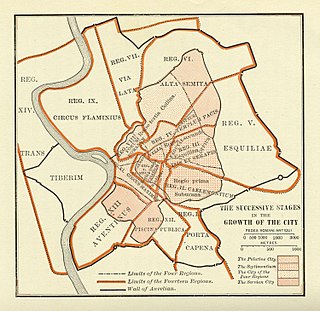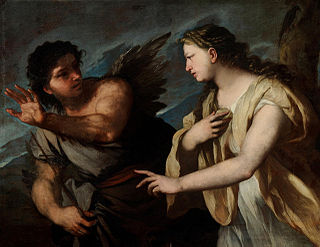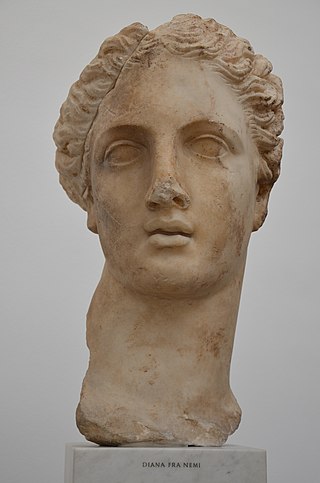
Hercules is the Roman equivalent of the Greek divine hero Heracles, son of Jupiter and the mortal Alcmena. In classical mythology, Hercules is famous for his strength and for his numerous far-ranging adventures.

The Roman Kingdom, also referred to as the Roman monarchy or the regal period of ancient Rome, was the earliest period of Roman history when the city and its territory were ruled by kings. According to tradition, the Roman Kingdom began with the city's founding c. 753 BC, with settlements around the Palatine Hill along the river Tiber in central Italy, and ended with the overthrow of the kings and the establishment of the Republic c. 509 BC.

In ancient Roman religion and myth, Faunus[ˈfau̯nʊs] was the rustic god of the forest, plains and fields; when he made cattle fertile, he was called Inuus. He came to be equated in literature with the Greek god Pan, after which Romans depicted him as a horned god.

Picus was a figure in Roman mythology, the first king of Latium. He was the son of Saturn, also known as Stercutus. He was the founder of the first Latin tribe and settlement, Laurentum, located a few miles to the Southeast of the site of the later city of Rome. He was known for his skill at augury and horsemanship.

In Roman mythology, Evander was a culture hero from Arcadia, Greece, who was said to have brought the Greek pantheon, laws, and alphabet to Italy, where he founded the city of Pallantium on the future site of Palatine Hill, Rome, sixty years before the Trojan War. He instituted the festival of the Lupercalia. Evander was deified after his death and an altar was constructed to him on the Aventine Hill.

In Greek and Roman mythology, Cacus was a fire-breathing giant and the son of Vulcan. He was killed by Hercules after terrorizing the Aventine Hill before the founding of Rome.

RheaSilvia, also known as Ilia, was the mythical mother of the twins Romulus and Remus, who founded the city of Rome. Her story is told in the first book of Ab Urbe Condita Libri of Livy and in Cassius Dio's Roman History. The Legend of Rhea Silvia recounts how she was raped by Mars while she was a Vestal Virgin and as a result became the mother of Romulus and Remus, the founders of Rome. This event was portrayed numerous times in Roman art and mentioned in the Aeneid and the works of Ovid.

The Aventine Hill is one of the Seven Hills on which ancient Rome was built. It belongs to Ripa, the modern twelfth rione, or ward, of Rome.
The Pons Sublicius is the earliest known bridge of ancient Rome, spanning the Tiber River near the Forum Boarium downstream from the Tiber Island, near the foot of the Aventine Hill. According to tradition, its construction was ordered by Ancus Marcius around 642 BC, but this date is approximate because there is no ancient record of its construction. Marcius wished to connect the newly fortified Janiculum Hill on the Etruscan side to the rest of Rome, augmenting the ferry that was there. The bridge was part of public works projects that included building a port at Ostia, at the time the location of worked salt deposits.

Diana Nemorensis, also known as "Diana of the Wood", was an Italic form of the goddess who became Hellenised during the fourth century BC and conflated with Artemis.
Pallantium was an ancient city near the Tiber river on the Italian peninsula. Roman mythology, as recounted in Virgil's Aeneid for example, states that the city was founded in Magna Graecia by Evander of Pallene and other ancient Greeks sometime previous to the Trojan War. In addition, Dionysius of Halicarnassus writes that Romans say that the city was founded by Greeks from Pallantium of Arcadia, about sixty years before the Trojan war and the leader was Evander. Solinus writes that the Arcadians were the founders of the city.

The kings of Alba Longa, or Alban kings, were a series of legendary kings of Latium, who ruled from the ancient city of Alba Longa. In the mythic tradition of ancient Rome, they fill the 400-year gap between the settlement of Aeneas in Italy and the founding of the city of Rome by Romulus. It was this line of descent to which the Julii claimed kinship. The traditional line of the Alban kings ends with Numitor, the grandfather of Romulus and Remus. One later king, Gaius Cluilius, is mentioned by Roman historians, although his relation to the original line, if any, is unknown; and after his death, a few generations after the time of Romulus, the city was destroyed by Tullus Hostilius, the third King of Rome, and its population transferred to Alba's daughter city.

Tiberinus is a figure in Roman mythology. He was the god of the Tiber River. He was added to the 3,000 rivers, as the genius of the Tiber.

Aventinus, one of the mythical kings of Alba Longa, who was buried on the Aventine Hill later named after him. He is said to have reigned thirty-seven years, and to have been succeeded by Procas, the father of Amulius.

Romulus was the legendary founder and first king of Rome. Various traditions attribute the establishment of many of Rome's oldest legal, political, religious, and social institutions to Romulus and his contemporaries. Although many of these traditions incorporate elements of folklore, and it is not clear to what extent a historical figure underlies the mythical Romulus, the events and institutions ascribed to him were central to the myths surrounding Rome's origins and cultural traditions.
In Roman mythology, Fabius was the son of Hercules and an unnamed mother.

The Temple of Diana was an edifice in ancient Rome which, according to the early semi-legendary history of Rome, was built in the 6th century BC during the reign of the king Servius Tullius.
The gens Silvia was a minor plebeian family at ancient Rome. According to legend, the Silvii were the royal dynasty of Alba Longa, Rome's mother city, and presumably came to Rome when that city was destroyed by Tullus Hostilius in the seventh century BC. Notwithstanding their connection with Rome's foundation myths, the Silvii were plebeians, and hardly any members of this gens played a significant role in history. However, from inscriptions, several Silvii appear to have had distinguished military careers, and Silvius Silvanus was governor of Moesia Inferior in the time of Diocletian.

The Regio XIII Aventinus is the thirteenth regio of imperial Rome, under Augustus's administrative reform. Regio XIII took its name from the hill which dominated the region, the Aventine.















